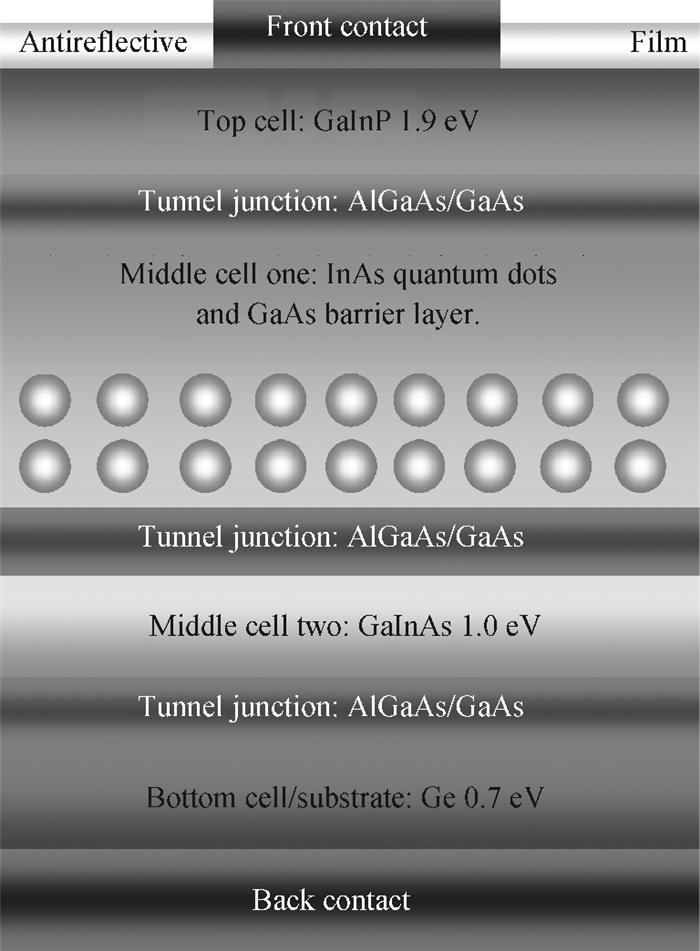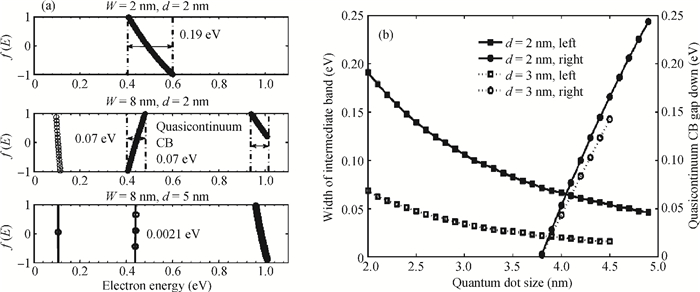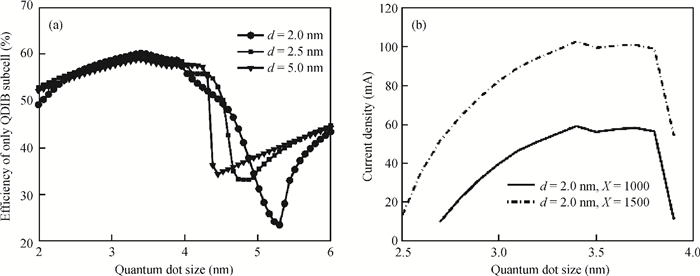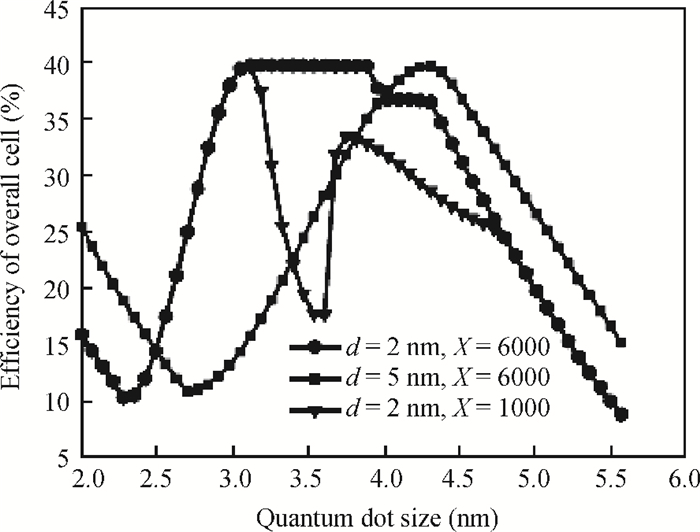| Citation: |
Xiaosheng Qu, Sisi Zhang, Hongyin Bao, Liling Xiong. The effect of InAs quantum-dot size and interdot distance on GaInP/GaAs/GaInAs/Ge multi-junction tandem solar cells[J]. Journal of Semiconductors, 2013, 34(6): 062003. doi: 10.1088/1674-4926/34/6/062003
****
X S Qu, S S Zhang, H Y Bao, L L Xiong. The effect of InAs quantum-dot size and interdot distance on GaInP/GaAs/GaInAs/Ge multi-junction tandem solar cells[J]. J. Semicond., 2013, 34(6): 062003. doi: 10.1088/1674-4926/34/6/062003.
|
The effect of InAs quantum-dot size and interdot distance on GaInP/GaAs/GaInAs/Ge multi-junction tandem solar cells
DOI: 10.1088/1674-4926/34/6/062003
More Information
-
Abstract
A metamorphic GaInP/GaAs/GaInAs/Ge multi-junction solar cell with InAs quantum dots is investigated, and the analytical expression of the energy conversion efficiency on the multi-junction tandem solar cell is derived using the detailed balance principle and the Kronig-Penney model. The influences of interdot distance, quantum-dot size and the intermediate band location on the energy conversion efficiency are studied. This shows that the maximum efficiency, as a function of quantum-dot size and distance, is about 60.15% under the maximum concentration for only one InAs/GaAs subcell, and is even up to 39.69% for the overall cell. In addition, other efficiency factors such as current mismatch, the formation of a quasicontinuum conduction band and concentrated light are examined. -
References
[1] Linares P G, Martí A, Antolín E, et al. Ⅲ-Ⅴ compound semiconductor screening for implementing quantum dot intermediate band solar cells. J Appl Phys, 2011, 109(1):014313 doi: 10.1063/1.3527912[2] Martí A, López N, Antolín E, et al. Novel semiconductor solar cell structures:the quantum dot intermediateband solar cell. Thin Solid Films, 2006, 511/512:638 http://cat.inist.fr/?aModele=afficheN&cpsidt=17880295[3] Luque A, Martí A. Increasing the efficiency of ideal solar cells by photon induced transitions at intermediate levels. Phys Rev Lett, 1997, 78(26):5014 doi: 10.1103/PhysRevLett.78.5014[4] Mehdipour A, Ogawa M, Souma S. Tight binding modeling of intermediate band solar cells based on InAs/GaAs quantum dot arrays. International Meeting for Future of Electron Devices, 2011:36 http://ieeexplore.ieee.org/document/5944832/authors[5] Ojajärvi J, Räsänen E, Sadewasser S, et al. Tetrahedral chalcopyrite quantum dots for solar-cell applications. Appl Phys Lett, 2011, 99(11):111907 doi: 10.1063/1.3640225[6] Guter W, Schone J, Philipps S P, et al. Current-matched triple-junction solar cell reaching 41.1% conversion efficiency under concentrated sunlight. Appl Phys Lett, 2009, 94(22):223504 doi: 10.1063/1.3148341[7] Roosbroeck W, Shockley W. Photon-radiative recombination of electrons and holes in germanium. Phys Rev Lett, 1954, 94:1558 doi: 10.1103/PhysRev.94.1558[8] Lazarenkova O L, Balandin A A. Miniband formation in a quantum dot crystal. J Appl Phys, 2001, 89(10):5509 doi: 10.1063/1.1366662[9] Vurgaftman I, Meyer J R, Ram-Mohan L R. Band parameters for Ⅲ-Ⅴ compound semiconductors and their alloys. J Appl Phys, 2001, 89(11):5815 doi: 10.1063/1.1368156[10] Shao Q, Balandin A A, Fedoseyev A I, et al. Intermediate-band solar cells based on quantum dot supracrystals. Appl Phys Lett, 2007, 91(16):163503 doi: 10.1063/1.2799172[11] Van Vechten J A, Bergstresser T K. Electronic structures of semiconductor alloys. Phys Rev B, 1970, 1:3351 doi: 10.1103/PhysRevB.1.3351[12] Luque A, Martí A, López N, et al. Experimental analysis of the quasi-Fermi level split in quantum dot intermediate-band solar cells. App Phys Lett, 2005, 87(8):083505 doi: 10.1063/1.2034090[13] Martí A, Cuadra L, Luque A. Partial filling of a quantum dot intermediate band for solar cells. IEEE Trans Electron Devices, 2001:2394 http://ieeexplore.ieee.org/document/954482/[14] Cuadra L, Martí L, Luque A. Quantum dot intermediate band solar cell. Conference Record of the 28th IEEE Photovoltaic Specialists Conference, 2000:940 http://ieeexplore.ieee.org/document/916039/authors[15] Cui M, Chen N F, Yang X L, et al. Fabrication and temperature dependence of a GaInP/GaAs/Ge tandem solar cell. Journal of Semiconductors, 2012, 33(2):024006 doi: 10.1088/1674-4926/33/2/024006 -
Proportional views





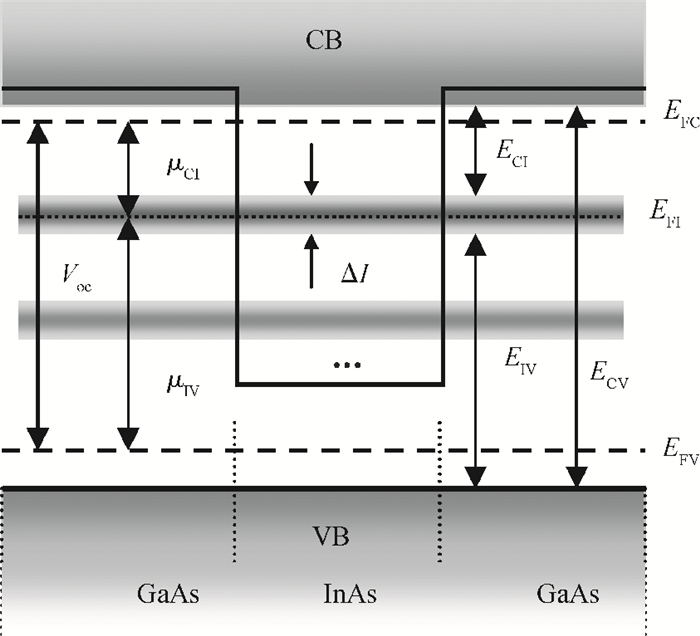
 DownLoad:
DownLoad:
